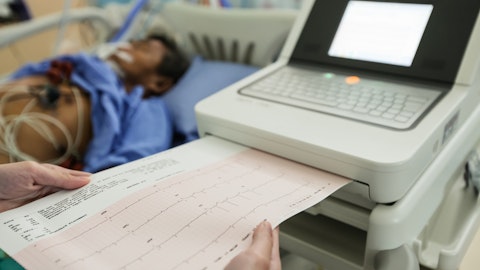Larry Biegelsen: Good morning. Congrats on the print. Mike, we’ve made it this far without GLP-1 question, but I’m going to ask it anyway. Obviously, diabetes and obesity are risk factors for many diseases such as cardiovascular disease. So, how are you thinking about the potential long-term impact of GLP-1s on your businesses, and any high level thoughts, Mike, on how investors have reacted to GLP-1s in general? Thank you.
Mike Mahoney: Dr. Stein, you want to give our comment on GLP-1?
Dr. Ken Stein: Yes, thanks, Mike, and hey, good morning, Larry. I think I’m going to begin, right, I mean, as a doc, I think you have to acknowledge these are promising agents. I think on the other hand, as a doc and a realist who’s lived through the launch of other promising agents in the past, and I think statins are a really good example, I think you’ve got to acknowledge, and particularly these drugs, given issues of cost, issues of convenience and issues of tolerability, we expect it will take at least a decade to reach peak penetration of these drugs in the indicated population. And even after a decade, we expect that only a minority of American patients with obesity will be taking these drugs. But if you think about these barriers to usage, I begin by saying, we see very limited short-term impact on cardiovascular disease, and even in the long-term, right, our analysis, taking into account, again, penetration ramp of these drugs, as I said, and taking into account what we know this far, thus far, about a reported 20% reduction in cardiovascular event rates, suggests to us that the impact on US coronary and peripheral procedure volumes will be minor even at peak.
And I think it’s important to state. So, we, even with these drugs, continue to expect both of these procedures to continue to grow in volume over the next decade. First of all, I think it’s also really important to point out that cardiovascular disease is a global issue, that there is less attribution to obesity in other regions, particularly Asia, making it less amenable to prevention with these drugs, which are frankly also very likely to be less accessible outside of the US. Also, any decrease in cardiovascular mortality and events will necessarily be accompanied by a corresponding increase in the prevalence of other diseases that are associated with aging, diseases in areas that are really very well served by our products, including things like cardiac pacing, interventional oncology for many forms of cancer, deep brain stimulation.
And finally, right, the assumptions that I’m talking to in terms of our modeling, right, don’t consider other procedural growth factors like an aging population over this period, and certainly doesn’t consider the long track record that we have of focusing and executing on innovation.
Larry Biegelsen: Thanks, Dr. Stein.
Operator: The next question is from the line of Travis Steed with Bank of America. Please go ahead.
Travis Steed: Hey, thanks for taking the question. I did want to ask about FARAPULSE. It sounded like the update was expected approval in second half 2024. Just curious when that was filed with the FDA. And maybe talk a little bit about scaling that up in the US and the potential to see pull-through on the ancillary products like mapping.
Lauren Tengler: Maybe you take the timing of launch, and you can speak to the value to the full portfolio.
Dr. Ken Stein: Yes, sure, Lauren. So, yes, on timing, again, as we said, I think everyone knows, right, our foundational pivotal scale data to submit to the FDA was ADVENT. Presented those results, as Mike said at, ESC, the end of August, with simultaneous publication in New England Journal of Medicine. Hit all of our endpoints, very clean data set. And so, again, as we’ve said, we’ve now completed our regulatory submission to the FDA and things are in the regulator’s hands. So, continue to expect approval second half of next year. And I think all of the EPs that I’ve spoken to in the US can’t wait to get their hands on it.
Mike Mahoney: Yes. You saw the results in the third quarter, which are quite strong with both POLARx and FARAPULSE. I think what’s important is our supply chain team has done a terrific job over the past 18 months in building supply of both catheters and the capital equipment needed. So, we expect to see a more significant install cadence to the back half of this quarter and into first quarter. So, we feel like we’ve really significantly improved our supply capabilities, and you’ll see that in 2024 in Europe, and we’ll be ready for the US launch.
Travis Steed: Great. Thanks a lot for the question. Congrats on the good quarter.
Operator: The next question is from the line of Danielle Antalffy with UBS. Please go ahead.
Danielle Antalffy: Hey, good morning, everyone. Thanks so much for taking the question. And congrats on a great quarter and the data here at TCT. Just a quick question on Q4 topline guide. I imagine there’s some conservatism baked in here, but if I’m looking at it correctly, is implying a little bit of a deceleration, and not to be nitpicky here, but just want to make sure we’re understanding of what the tailwinds versus headwinds are as we go into Q4 and heading into 2024. Thanks so much.
Dan Brennan: Sure, Danielle. Yes, I think of note, if you think back to our July guidance, obviously we didn’t give specific Q4 guidance, but implied in that guidance would’ve been 7% to 9%. So, the 8% to 10% that we have for the fourth quarter is a bit of acceleration from where that would’ve been. As always, we think the 8% to 10% is a prudent number for the quarter, and believe it’s the right number for the quarter for – to close out the year. It’ll put us at 11%, approximately 11% organic revenue growth for the year. So, I think that’s a great year for the company. And you combine that with the other metrics that we have, not just revenue, but the 11% organic revenue growth, you’d see 80 basis points of margin expansion at that 26.4% adjusted op margin. And then you get to 17% to 18% full-year EPS at that $1.99 to kind of that milestone over $2 to get to that $2.02. That’s a good year.
Danielle Antalffy: Thank you.
Operator: The next question is from the line of Matt Taylor with Jefferies. Please go ahead.
Matt Taylor: Hi, thanks for taking the question. I actually wanted to ask one on neuromodulation. You talked about results below expectations in light of competitive dynamics. So, I was hoping you could comment on that and whether you expect any improvement in growth now that you have the PDN indication.
Mike Mahoney: Sure, Matt. Yes, there’s been a couple of new entrants into the field over the last 12 months. And so, they’ve taken a little bit of market share. Overall, the market’s likely, I don’t know, 5% to 6%-ish, and this year we’re likely to – in SCS US, likely be below the market. I mentioned earlier, a big driver there is not having the support of DPN, which we just recently received in October. And we expect to be able to offer that capability in line with some of our competitors in first quarter 2024. So, we do expect to have a softer fourth quarter, and then we expect acceleration improvement in 2024 versus 2023 for our SCS business and our Brain business. DBS continues to take share and grow double digits, and again, mentioned it’s likely the only division that’s grown below the market.
Matt Taylor: Great. Thanks, Mike.
Operator: The next question is from the line of Josh Jennings with TD Cowen. Please go ahead.
Josh Jennings: Hi, good morning. Congratulations on the strong results, and wanted to follow up on Travis’s question on FARAPULSE. Was hoping to just better understand where your US EP sales force stands today and how you’re building that out, your plan to build that out and for the FARAPULSE launch. And then just on top of that, just thinking about the full integration of FARAPULSE and arrhythmia and developing these FARAVIEW capabilities, is there anything of note that we should be thinking about that would provide clinical advantages that could catalyze stronger demand for arrhythmia once that integration is completed, I believe at the year-end of 2024? Thanks for taking the questions.
Mike Mahoney: Sure. Yes. I won’t go into all too many specifics on our commercial strategy. We do have a scaled and trained EP sales force, as you imagine, given the capabilities we have with our WATCHMAN division and our EP business and our CRM business. So, we have a scaled EP force that’s been trained up now, and what’s great to see is they’re successfully selling cryo today. So, having the approval of that, and we had a really nice initial, I don’t know, 30 days or so of cryo openings. So, we expect to see cryo to be a nice revenue driver force in 2024 as we wait for the FARAPULSE approval. So, we do have a scaled, highly capable EP commercial team. And Ken, if you want to comment on the arrhythmia offerings.





